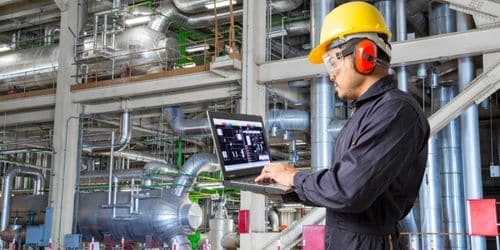Predictive maintenance (PdM) is a way to keep equipment and processes from breaking down. It uses data analysis tools and techniques to find out the ordinary things happening in your operation and possible problems. This article talks about machine learning predictive maintenance software and techniques. It also discusses predictive maintenance vs preventive maintenance.
How Does Predictive Maintenance Work?
Predictive maintenance looks at operational data from the past and the present to predict and stop possible breakdowns. Your business is affected by the following predictive maintenance in three main ways:
- The process of keeping track of how well and how healthy an asset is.
- Service requests are mined for data.
- Using the MRO inventory as a guide.
- Getting help and support from key players by educating them.
- Keeping track of all the equipment and carefully judging it.
- Choose the equipment for the program’s test run.
- Putting together information about a system by breaking it down into its parts.
Predictive maintenance depends on a lot of things, but one of the most important is the use of new technology and the right software. IoT, AI, and integrated systems, in particular, make it possible for assets and systems that are not connected to each other to talk to each other, coordinate their work, and act on the results of shared data analysis. Data collection is done with the help of predictive maintenance sensors, factory controls, and enterprise systems (like EAM software and ERP software).
Problem areas are found by looking at the information and analyzing it. With sensors made for that purpose, you can do predictive maintenance like oil analysis, vibration analysis, thermal imaging, and equipment observation.
Predictive Maintenance Software
By using powerful equipment monitoring tools and data analytics, predictive maintenance software analyzes the performance of assets and predicts when they might break down. With this information, businesses can come up with preventive maintenance plans, which will cut down on unplanned downtime. Predictive maintenance software automates the maintenance process by setting up maintenance at the first sign of a possible problem with a piece of equipment, rather than waiting until it breaks to fix it.
Prognostic Upkeep The software looks at the machines that are already in use and tells you exactly when and how much maintenance should be done. Its goal is to make sure that machinery gets regular maintenance checks instead of waiting until it breaks down. This keeps the company from having to fix things quickly during the shutdown.
Software made for maintenance planning keeps track of the health and performance of equipment over time so that breakdowns can be planned for and repairs can be made.
Predictive maintenance software uses sensors and gauges that are put into machines to track and record things like how often they vibrate, how loud they are, and what temperature they are running at. The software then uses analytics for preventive maintenance to figure out if the problem needs to be fixed. By spotting the first signs that a piece of machinery is going to break down, predictive maintenance software lets companies avoid reactive maintenance. The following is a list of the best predictive maintenance programs.
#1. Siemens’s Mindsphere
Siemens MindSphere is an IoT operating system that is open and runs in the cloud. It connects the digital and physical worlds by collecting and analyzing huge amounts of data from a network of billions of smart devices. MindSphere also has powerful industrial apps and digital services that can free up more resources by reducing downtime, increasing production, and making better use of assets.
#2. GE Predix
GE Predix is an industrial Internet of Things (IoT) platform that combines advanced asset modeling, big data processing, analytics, and applications to build the technological backbone of manufacturing operations of the future. With GE Predix, it is possible to come up with new ideas quickly, improve the performance of assets, invest wisely, and plan for the future in a strategic way.
#3. Presenso
Rule-based legacy systems can’t limit production downtime because they are reactive and have limited computing power. This costs manufacturers and plant operators millions of dollars every year. Presenso is a cloud-based software solution that was one of the first to use AI for predictive asset management in real-time. Presenso increases output and income by giving deep semantic insights and operational intelligence that have never been seen before.
Predictive Maintenance Techniques
Sensors are a common part of tools and methods for condition monitoring, and they must be installed on assets for data to be collected and sent to CMMS programs. The program combines data from real-time sensors, historical data, and prediction algorithms to give maintenance teams a full picture of what to expect.
In order to do preventative maintenance, sensor data is essential. IoT By putting sensors in machinery, you can keep an eye on the temperature, vibration, pressure, sound, and other things. Choose the right technologies and PdM methods for your maintenance plan if you want to get the most out of it. The following are the techniques for predictive maintenance:
#1. Monitoring of Acoustic Analysis
This method listens to the frequencies at which machines make noise to find technical problems and find out why they are happening. Even though we can’t hear them, most machines still make sounds. Maintenance workers can find wear and breakage in rotating gear before it causes damage by using acoustic sensors. Teams doing maintenance can use acoustic technologies to listen for the hissing or pinging sounds of gas, liquid, or vacuum leaking out of broken machinery.
#2. Analysis of Motor Circuits
In motor circuit analysis, electronic signature analysis (ESA) is used to predict problems with electric motors before they happen. The electronic signature analysis looks at a motor’s supply voltage and operating current to figure out what’s wrong.
#3. Analyzing Vibrations
Vibration monitoring is a type of preventive maintenance that can be done with either a sensor that is permanently attached or a portable analyzer. This type of preventive maintenance is often used on high-speed rotating equipment. However, with vibration analysis, problems like misalignment, bent shafts, parts that aren’t in balance, loose mechanical parts, and motor problems can be found.
#4. Pdm Oil Analysis
Oil analysis is another non-invasive method of PdM that works well. Oil samples are used to look for worn parts in machinery. It also looks at the amount and size of oil samples to figure out how the machinery is doing.
Machine Learning Predictive Maintenance
Prognostic Upkeep With the help of Machine Learning predictive maintenance, you can now use a sample set of data or your own data to automatically process the data. The ML model that has been added can predict when equipment will break down and suggest how to fix it. Prognostic Upkeep We can use a machine learning (ML) model and data from a simulation of turbofan degradation to figure out when machines might break down.
Using this Advice, a piece of equipment’s possible failure can be found automatically, and the next steps can be suggested. It’s easy to set up and comes with a sample dataset, but the code can be easily changed to work with other types of data. Using machine learning, there are two main ways to do predictive maintenance:
#1. Classification Approach
Using this method in machine learning predictive maintenance, you can predict whether the next n steps will work or not. It also lets us know if any of the other steps are likely to fail.
#2. The Method of Regression
Using this method, you can predict when a system will break down. This idea is like the one behind Useful Life Left Over (RUL). Regression requires more data to forecast failure than classification, but it provides more information. Today, machine learning-based predictive maintenance is utilized to detect system failure and prevent it.
Predictive Maintenance vs Preventive Maintenance
In predictive vs Preventive maintenance, preventive maintenance is scheduled regularly but not always. On the other hand, predictive maintenance is scheduled only when it’s needed based on the asset’s condition.
Preventive maintenance is planned and done on machines to reduce the chance of breakdowns and make them less severe when they do happen. These regular tasks have to be done whether or not the machine is working properly.
Predictive maintenance, unlike preventive maintenance, is based on asset performance rather than data or schedules. In the same research, the US Department of Energy claims it can save 25–30% over reactive maintenance.
But, predictive maintenance managers consider how the asset is used and its current state to determine when to perform maintenance. The following below are more predictive maintenance vs preventive maintenance.
- Preventive maintenance can be done at any time, but predictive maintenance needs to start with gathering information.
- In predictive maintenance vs preventive maintenance, during preventive maintenance, machines need to be turned off for inspections and routine checks, but predictive maintenance can be done while they are running.
- For preventive maintenance, businesses need to buy replacement parts ahead of time and organize their stock, but for predictive maintenance, you only need to buy the parts your system actually needs.
What Kinds of Predictive Maintenance Are There?
Predictive maintenance can be put into a few different groups, such as:
#1. Analyzing Vibrations
In this type of preventive maintenance, sensors are used to track the vibrations of machinery and find any changes that could mean there is a problem. Vibrational analysis can be used to find wear, misalignment, and slop in equipment.
#2. The Infrared Evaluation
This maintenance involves monitoring equipment temperatures for issues. As temperature changes are generally the first symptom of a problem, businesses can employ thermal imaging to monitor their assets.
#3. Analysis of Sound
This method of preventive maintenance involves listening for changes in how loud equipment or assets are. Ultrasonic sensors used in predictive maintenance can pick up on small changes in sound that workers can’t hear. This can be a sign that the equipment needs to be fixed. Both stand-alone and combined predictive maintenance solutions can be used to get a good idea of how healthy a machine is. Companies can use this information to figure out the state of their assets and decide if they need to be fixed.
The Pros and Cons of Predictive Maintenance
The followings are the pros and cons of predictive maintenance:
Predictive analysis helps save money, which is why it is being used more and more in the manufacturing sector (Immerman, “The Effect of Predictive Maintenance on Manufacturing”). Predictive maintenance has many other benefits, but it can also change maintenance departments and businesses as a whole by helping asset managers reach their goals and find a better balance between things like profit and uptime, which are often at odds with each other.
One of the biggest problems with PdM is that it takes a long time to evaluate and put a schedule in place. Predictive maintenance is a difficult task that requires a lot of training for both how to use the equipment and how to understand the analytics (or data).
Condition-monitoring contractors are experts at doing the work and figuring out what it all means for a building. However, many companies choose to teach their current employees about predictive analysis instead. Predictive maintenance requires money to be spent on tools and systems for maintenance, as well as money to train employees on how to use them. Since cloud computing came along, this cost has slowly gone down.
What Is Predictive Maintenance for Example?
With predictive analysis, assets can be checked all the time, which gives information that can be used to make an analysis plan for each asset. This method helps extend the useful life of an asset while lowering the costs of maintaining it each year.
What Are the Three Types of Predictive Maintenance?
The following are;
- Corrective maintenance.
- Preventive maintenance.
- Maintenance is based on risk.
- Condition-based maintenance.
- Predetermined maintenance.
What Is Predictive Maintenance in the Industry?
Predictive maintenance (PdM) is a way to save money on emergency repairs and downtime by figuring out what repairs might need to be done in the future. Connecting to devices and looking at the data they send out can help figure out why they aren’t working. The predictive analysis employs condition-monitoring techniques to monitor how well a structure or piece of equipment is functioning while it is in use.
What Are PM and CM in Maintenance?
Corrective maintenance (CM) is what technicians do to fix problems and get broken tools and machines back in working order. Corrective maintenance tasks, on the other hand, can be planned or done on the spot. Predictive maintenance tasks focus on preventing unexpected breakdowns. All of your assets and machines should get regular preventive maintenance (PM) to avoid expensive unplanned downtime caused by unexpected equipment failure.
What Are the 5 Maintenance Strategies?
There are five main ways to do maintenance, and each has its own pros and cons: planned (or preventative), reactive, predictive, condition-based, and reliability-based.
Conclusion
With predictive maintenance, repairs can be done as rarely as possible without having to pay for too much preventive maintenance. This keeps unplanned reactive maintenance from happening. It is best to talk to the people who made the equipment and experts in condition monitoring to figure out the best way to do condition monitoring.
Related Articles
- PREDICTIVE ANALYSIS: What It Is, Example, Tools & Importance
- Predictive Analytics: Definition, Examples, and Benefits
- What is Risk Management? Structures, Importance & Analysis
- Predictive vs Prescriptive Analytics, Explained!!! (+ Detailed Guide)
- Predictive Analytics Tools and Software: Best 15+ Tools
- WORK MANAGEMENT SYSTEM WMS: Definition and How It Works
- WORK PERFORMANCE: Best 15+ Ways to Improve Performance & Review.






